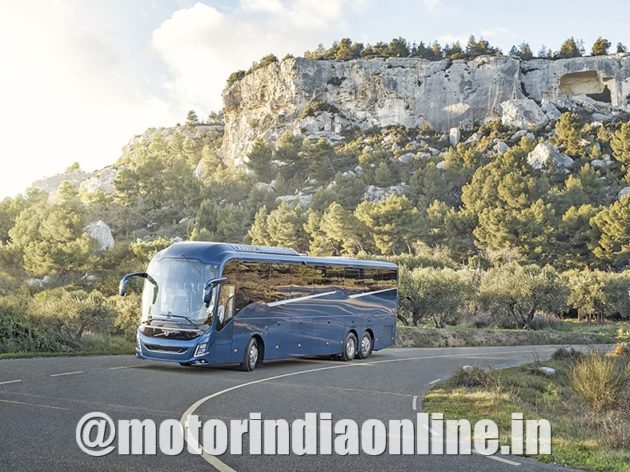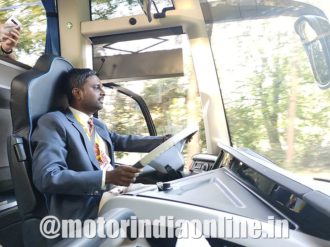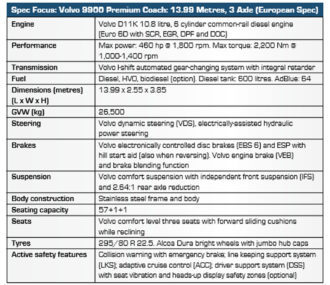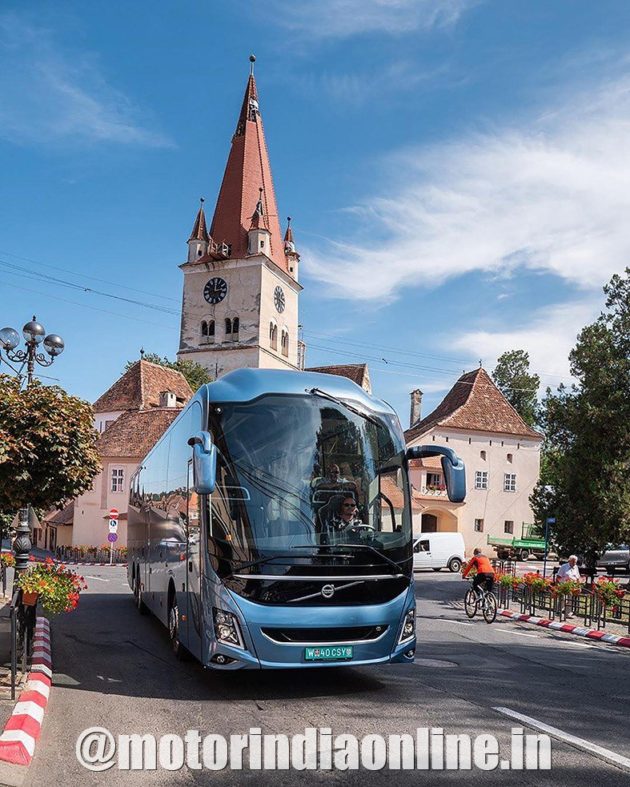The fourth-generation Volvo 9900 premium coach was born out of a mission to offer the European market the ultimate coach experience etched by luxury and safety in all aspects. It is fashioned in such a way that it radiates a sense of elegance and cosiness with no arrogance or callousness whatsoever, despite being one of the beastiest machines in its class. In this MOTORINDIA exclusive, senior correspondent and test driver Dhiyanesh Ravichandran brings an account of his remarkable encounter with this beauty on the roads of Brussels, Belgium

When Volvo Buses told us that its latest ‘top-spec’ premium coach is up for test drives, I thought to myself, “Hell, no way!”. As I walked down the boulevard facing the landmark building Atomium in the city of Brussels where the demo vehicle was parked, the stunning looks of the 9900 was simply mesmerizing. “Yes, it is happening,” I assured my anxious self. For a person who grew up watching magnificent automobiles, Volvo Buses have always inspired me with awe and reverence – the 9000 coach range, in particular, is the connoisseur of my bus world! The visual impression emanating from the coach was nothing compared to what I could recollect from those numerous online visuals I must have binged on since its launch.
The Design Features
The marvel of our land – Volvo 9400 – was not even kind of close to the serenity of its high-class European sibling, frankly speaking! Let me put my account of Volvo 9900’s design and styling in perspective before I lay out my driving experiences. One distinctive trait that sets this coach apart from the rest of the 9000s and their rivals is its Z-shaped window line. Each section of the window pane is of different size and shape, while also rendering the side profile a dynamic impression of forward movement. The Z-shape detailing follows the alignment of the theatre-style floor inside the coach – an upward sloping layout from front to rear that offers all passengers a better forward view over those sitting in front of them.

The front and rear fascia also draw styling cues from the vibrant ‘Z’ theme, including the Volvo FMX-inspired headlamp DRLs, angled rear windscreen, slender tail lamps and horizontal air outlets from the engine compartment. The silhouette of the 9900 is aerodynamically fashioned, with a not-so-heavy looking top and suave edges. Volvo says the front structure incorporates a host of safety features, for instance, enhanced head-on impact protection by preventing colliding objects from penetrating the vehicle, while also eliminating fire risks and ensuring the driver’s knee protection. The black moulding below the front windscreen is not just an aesthetic embellishment but accommodates radar for the lane assist system to alert the driver.
Thus, the 9900 is more than just styling. Designers at Volvo have ensured that the styling is neither brute nor aggressive, but balanced and friendly, and I think that conveys a lot to its customers and brand-conscious tourists – the end-users – in Europe. The ingenious way of designing things to help deliver the brand’s core values goes on with the interiors as well. As I step in, the 9900’s cabin feels just like that of a luxury sedan or a business jet. All the bits and pieces are fashioned in such a way that they serve some definitive function, while also instinctive and comforting for the driver and passengers to make use of them.

The entranceway and the aisle are generous; the leather seats are comfy and spacious with ample legroom; there are foldaway tables on the seatbacks for all passengers; the aircraft-style overhead luggage bins and functional service units housing air-conditioning vents and reading lights are impeccable. Together with the sloping floorboard and large windows, the 9900’s interiors are simply irresistible. However, I was keen on getting on to the driver seat. It may seem that I may indulge in some hyperbole in my account on the Volvo, but the 9900’s driving seat ergonomics and driver’s compartment is the best among all I have encountered so far. The layout is quite harmonious and functional, with the steering wheel, instrumentation, driving controls and buttons at my convenient reach.
The air-suspended seat is too premium for my liking (we are not used to that kind of comfort levels in India!), while the commanding view and secure feeling it offers while driving is phenomenal. The driving view is enhanced by an expansive windscreen and clearer glass panes on either side, unhindered by the A-pillars, including the two on the door to watch out for pedestrians or motorcycles alongside the coach. At this point, I have to confess that I am skipping a long list of functional features and technological goodies that kept me awestruck all though the drive – from the ‘Alcolock’ breath test to unlock the engine to sophisticated collision warning with emergency braking. I can’t afford to make this report a never-ending one!
The Driving Experience
Needless to say, Volvo’s integration of driver ergonomics and safety (and driver-assist) technologies right from the drawing board is well-acclaimed. This ‘ground-up’ approach redefines driving dynamics and comfort levels on road, something that I found so exciting and liberating for a driver. Exciting because the driving is incredibly smooth with no vibrations and low engine or road noise, even when I step on the throttle or brake hard like a maniac. The dynamic steering takes some getting used to, but it instils enough confidence in the driver to quickly adapt. The 9900 I drove is the longest (13.99 metres) and tallest (3.85 metres) variant of the Volvo’s portfolio.
This top-of-the-line variant, unveiled in 2018, was conceived so on purpose, which translates into additional capacities for the operator. Considering its dimensions, the bus should drive and handle like a boat, but a big no! It was quite easy to handle and operate, even while juggling with the day time traffic and narrow city lanes of Brussels. My heart skipped a beat for the refinement of the 460 hp engine (D11K), and together with the I-shift gearbox, the 9900 packs a punch. On bumpy stretches and at higher speeds, the coach feels no different in terms of ride quality and stability, thanks to Volvo comfort suspension that lowers the vehicle by 20 mm once past 80 kmph, thereby reducing drag and fuel consumption.
On the other hand, the coach is quite liberating for the driver, in the sense that I felt largely relieved of the anxieties to ensure a safe and comfy ride experience for my passengers. I don’t have to strain too much or scatter my energy too much. The vehicle is smart enough to do the needful. The optimised driving position makes me less tired; rather I can just focus all my attention on objects on the road and just wade through safe and study. I think that’s where high-spec products like this one would make a difference to its driver and the operator. On the whole, the Volvo 9900 is prodigious with a truly integrated structural design as against a typical chassis-body combo; it is tuned for high-performance, comfort, and safety; while Volvo’s brand reputation towards maximum uptime is a boon – a complete package in itself.

Beauty and the Beast
Now, let’s go back to my titular poser – beauty versus beast. Premium and high-performance vehicles are designed to look and behave like beasts. They have to be aggressive, brute and powerful. However, the catch is that not every vehicle can afford to be a beast at all times, even if it is capable of being so. Private vehicles such as supercars, sport sedans or off-road pick-ups can be beasty. But buses shouldn’t be since a lot of things like passenger safety, operational costs and ownership aspects are at stake. The Volvo 9900 is nothing short of an exhilarating beast. Just that it doesn’t want to be one. Rather, it likes to be elegant but stern on delivering its promises and the maker’s core values of opulence and safety. Much to everyone’s envy!